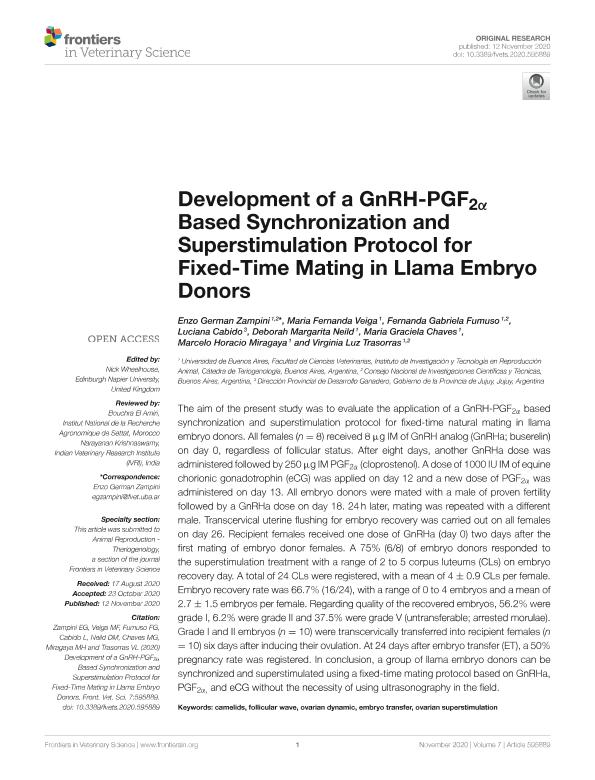Mostrar el registro sencillo del ítem
dc.contributor.author
Zampini, Enzo German

dc.contributor.author
Veiga, Maria Fernanda

dc.contributor.author
Fumuso, Fernanda Gabriela

dc.contributor.author
Cabido, Luciana
dc.contributor.author
Neild, Deborah Margarita
dc.contributor.author
Chaves, María Graciela

dc.contributor.author
Miragaya, Marcelo Horacio
dc.contributor.author
Trasorras, Virginia Luz

dc.date.available
2021-03-19T14:15:54Z
dc.date.issued
2020-11-12
dc.identifier.citation
Zampini, Enzo German; Veiga, Maria Fernanda; Fumuso, Fernanda Gabriela; Cabido, Luciana; Neild, Deborah Margarita; et al.; Development of a GnRH-PGF2α based synchronization and superstimulation protocol for fixed-time mating in llama embryo donors; Frontiers Media S.A.; Frontiers in Veterinary Science; 7; 595889; 12-11-2020; 1-6
dc.identifier.uri
http://hdl.handle.net/11336/128637
dc.description.abstract
The aim of the present study was to evaluate the application of a GnRH-PGF2α based synchronization and superstimulation protocol for fixed-time natural mating in llama embryo donors. All females (n = 8) received 8 μg IM of GnRH analog (GnRHa; buserelin) on day 0, regardless of follicular status. After eight days, another GnRHa dose was administered followed by 250 μg IM PGF2α (cloprostenol). A dose of 1000 IU IM of equine chorionic gonadotrophin (eCG) was applied on day 12 and a new dose of PGF2α was administered on day 13. All embryo donors were mated with a male of proven fertility followed by a GnRHa dose on day 18. 24 h later, mating was repeated with a different male. Transcervical uterine flushing for embryo recovery was carried out on all females on day 26. Recipient females received one dose of GnRHa (day 0) two days after the first mating of embryo donor females. A 75% (6/8) of embryo donors responded to the superstimulation treatment with a range of 2 to 5 corpus luteums (CLs) on embryo recovery day. A total of 24 CLs were registered, with a mean of 4 ± 0.9 CLs per female. Embryo recovery rate was 66.7% (16/24), with a range of 0 to 4 embryos and a mean of 2.7 ± 1.5 embryos per female. Regarding quality of the recovered embryos, 56.2% were grade I, 6.2% were grade II and 37.5% were grade V (untransferable; arrested morulae). Grade I and II embryos (n = 10) were transcervically transferred into recipient females (n = 10) six days after inducing their ovulation. At 24 days after embryo transfer (ET), a 50% pregnancy rate was registered. In conclusion, a group of llama embryo donors can be synchronized and superstimulated using a fixed-time mating protocol based on GnRHa, PGF2α, and eCG without the necessity of using ultrasonography in the field.
dc.format
application/pdf
dc.language.iso
eng
dc.publisher
Frontiers Media S.A.

dc.rights
info:eu-repo/semantics/openAccess
dc.rights.uri
https://creativecommons.org/licenses/by/2.5/ar/
dc.subject
CAMELIDS
dc.subject
EMBRYO TRANSFER
dc.subject
FOLLICULAR WAVE
dc.subject
OVARIAN DYNAMIC
dc.subject
OVARIAN SUPERSTIMULATION
dc.subject.classification
Otras Ciencias Veterinarias

dc.subject.classification
Ciencias Veterinarias

dc.subject.classification
CIENCIAS AGRÍCOLAS

dc.title
Development of a GnRH-PGF2α based synchronization and superstimulation protocol for fixed-time mating in llama embryo donors
dc.type
info:eu-repo/semantics/article
dc.type
info:ar-repo/semantics/artículo
dc.type
info:eu-repo/semantics/publishedVersion
dc.date.updated
2021-03-05T18:46:57Z
dc.identifier.eissn
2297-1769
dc.journal.volume
7
dc.journal.number
595889
dc.journal.pagination
1-6
dc.journal.pais
Suiza

dc.description.fil
Fil: Zampini, Enzo German. Universidad de Buenos Aires. Facultad de Ciencias Veterinarias. Area de Teriogenología; Argentina. Consejo Nacional de Investigaciones Científicas y Técnicas; Argentina
dc.description.fil
Fil: Veiga, Maria Fernanda. Universidad de Buenos Aires. Facultad de Ciencias Veterinarias. Area de Teriogenología; Argentina
dc.description.fil
Fil: Fumuso, Fernanda Gabriela. Universidad de Buenos Aires. Facultad de Ciencias Veterinarias. Area de Teriogenología; Argentina. Consejo Nacional de Investigaciones Científicas y Técnicas; Argentina
dc.description.fil
Fil: Cabido, Luciana. Gobierno de la Provincia de Jujuy. Dirección Provincial de Desarrollo Ganadero; Argentina
dc.description.fil
Fil: Neild, Deborah Margarita. Universidad de Buenos Aires. Facultad de Ciencias Veterinarias. Area de Teriogenología; Argentina
dc.description.fil
Fil: Chaves, María Graciela. Universidad de Buenos Aires. Facultad de Ciencias Veterinarias. Area de Teriogenología; Argentina
dc.description.fil
Fil: Miragaya, Marcelo Horacio. Universidad de Buenos Aires. Facultad de Ciencias Veterinarias. Area de Teriogenología; Argentina
dc.description.fil
Fil: Trasorras, Virginia Luz. Universidad de Buenos Aires. Facultad de Ciencias Veterinarias. Area de Teriogenología; Argentina. Consejo Nacional de Investigaciones Científicas y Técnicas; Argentina
dc.journal.title
Frontiers in Veterinary Science
dc.relation.alternativeid
info:eu-repo/semantics/altIdentifier/url/https://www.frontiersin.org/articles/10.3389/fvets.2020.595889/full
dc.relation.alternativeid
info:eu-repo/semantics/altIdentifier/doi/https://doi.org/10.3389/fvets.2020.595889
Archivos asociados
